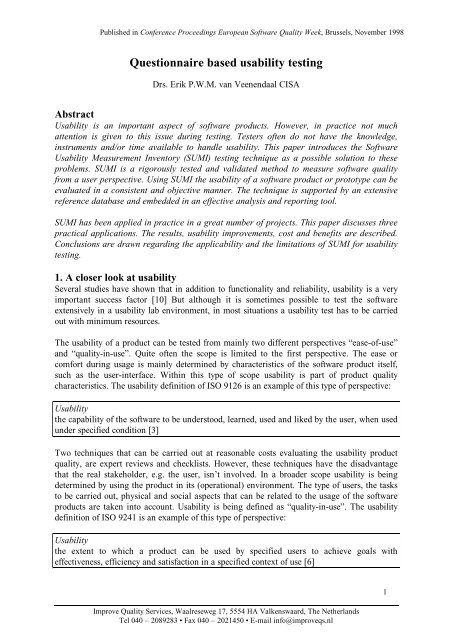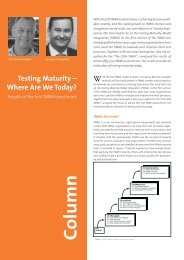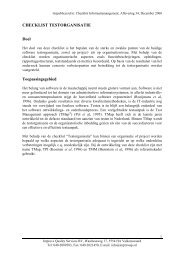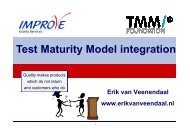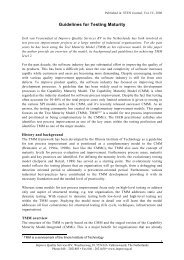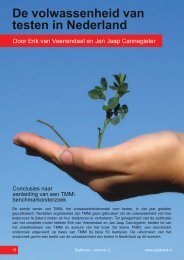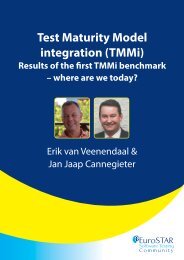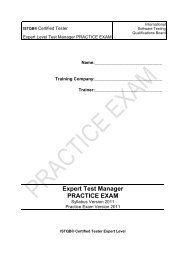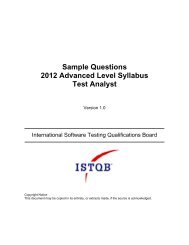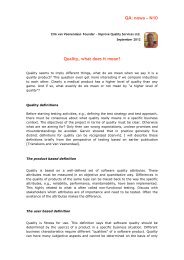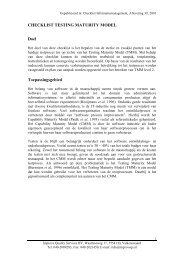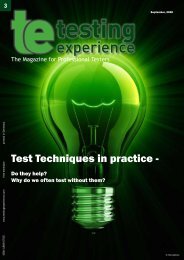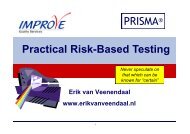Questionnaire based usability testing - Erik van Veenendaal
Questionnaire based usability testing - Erik van Veenendaal
Questionnaire based usability testing - Erik van Veenendaal
Create successful ePaper yourself
Turn your PDF publications into a flip-book with our unique Google optimized e-Paper software.
Published in Conference Proceedings European Software Quality Week, Brussels, November 1998<strong>Questionnaire</strong> <strong>based</strong> <strong>usability</strong> <strong>testing</strong>Drs. <strong>Erik</strong> P.W.M. <strong>van</strong> <strong>Veenendaal</strong> CISAAbstractUsability is an important aspect of software products. However, in practice not muchattention is given to this issue during <strong>testing</strong>. Testers often do not have the knowledge,instruments and/or time available to handle <strong>usability</strong>. This paper introduces the SoftwareUsability Measurement Inventory (SUMI) <strong>testing</strong> technique as a possible solution to theseproblems. SUMI is a rigorously tested and validated method to measure software qualityfrom a user perspective. Using SUMI the <strong>usability</strong> of a software product or prototype can beevaluated in a consistent and objective manner. The technique is supported by an extensivereference database and embedded in an effective analysis and reporting tool.SUMI has been applied in practice in a great number of projects. This paper discusses threepractical applications. The results, <strong>usability</strong> improvements, cost and benefits are described.Conclusions are drawn regarding the applicability and the limitations of SUMI for <strong>usability</strong><strong>testing</strong>.1. A closer look at <strong>usability</strong>Several studies have shown that in addition to functionality and reliability, <strong>usability</strong> is a veryimportant success factor [10] But although it is sometimes possible to test the softwareextensively in a <strong>usability</strong> lab environment, in most situations a <strong>usability</strong> test has to be carriedout with minimum resources.The <strong>usability</strong> of a product can be tested from mainly two different perspectives “ease-of-use”and “quality-in-use”. Quite often the scope is limited to the first perspective. The ease orcomfort during usage is mainly determined by characteristics of the software product itself,such as the user-interface. Within this type of scope <strong>usability</strong> is part of product qualitycharacteristics. The <strong>usability</strong> definition of ISO 9126 is an example of this type of perspective:Usabilitythe capability of the software to be understood, learned, used and liked by the user, when usedunder specified condition [3]Two techniques that can be carried out at reasonable costs evaluating the <strong>usability</strong> productquality, are expert reviews and checklists. However, these techniques have the disad<strong>van</strong>tagethat the real stakeholder, e.g. the user, isn’t involved. In a broader scope <strong>usability</strong> is beingdetermined by using the product in its (operational) environment. The type of users, the tasksto be carried out, physical and social aspects that can be related to the usage of the softwareproducts are taken into account. Usability is being defined as “quality-in-use”. The <strong>usability</strong>definition of ISO 9241 is an example of this type of perspective:Usabilitythe extent to which a product can be used by specified users to achieve goals witheffectiveness, efficiency and satisfaction in a specified context of use [6]Improve Quality Services, Waalreseweg 17, 5554 HA Valkenswaard, The NetherlandsTel 040 – 2089283 • Fax 040 – 2021450 • E-mail info@improveqs.nl1
Published in Conference Proceedings European Software Quality Week, Brussels, November 1998Clearly these two perspective of <strong>usability</strong> are not independent. Achieving “quality-in-use” isdependent on meeting criteria for product quality. The interrelationship is shown in figure 1.productqualityinfluencesdepends onqualityin useFigure 1 : Relationship between different types of <strong>usability</strong>Establishing test scenarios, for instance <strong>based</strong> on use cases [7], can be applied to test <strong>usability</strong>in accordance with ISO 9241. However, <strong>usability</strong> <strong>testing</strong> with specified test cases / scenarios isa big step for most organization and often not even necessary. From a situation where <strong>usability</strong>is not tested at all one wants a technique that involves users, is reliable but still requires limitedresources.Within the European ESPRIT project MUSiC [ESPRIT 5429] a method has been developedthat serves to determine the quality of a software product from a user’ perspective. SoftwareUsability Measurement Inventory (SUMI) is a questionnaire <strong>based</strong> method that can beendesigned for cost effective usage.2. What is SUMI?Software Usability Measurement Inventory (SUMI) is a solution to the recurring problem ofmeasuring users' perception of the <strong>usability</strong> of software. It provides a valid and reliable methodfor the comparison of (competing) products and differing versions of the same product, aswell as providing diagnostic information for future developments. It consists of a 50-itemquestionnaire devised in accordance with psychometric practice. Each of the questions isanswered with "agree", "undecided" or "disagree". The following sample shows the kind ofquestions that are asked:• This software responds too slowly to inputs• I would recommend this software to my colleagues• The instructions and prompts are helpful• I sometimes wonder if I am using the right command• Working with this software is satisfactory• The way that system information is presented is clear and understandable• I think this software is consistent.The SUMI questionnaire is available in English (UK and US), French, German, Dutch,Spanish, Italian, Greek and Swedish.SUMI is intended to be administered to a sample of users who have had some experience ofusing the software to be evaluated. In order to use SUMI effectively a minimum of ten users isrecommended. Based on the answers given and statistical concepts the <strong>usability</strong> scores arebeing calculated. Of course SUMI needs a working version of the software before SUMI canbe measured. This working version can also be a prototype or a test release.Improve Quality Services, Waalreseweg 17, 5554 HA Valkenswaard, The NetherlandsTel 040 – 2089283 • Fax 040 – 2021450 • E-mail info@improveqs.nl2
Published in Conference Proceedings European Software Quality Week, Brussels, November 1998One of the most important aspects of SUMI has been the development of the standardizationdatabase, which now consists of <strong>usability</strong> profiles of over 2000 different kinds of applications.Basically any kind of application can be evaluated using SUMI as long as it has user inputthrough keyboard or pointing device, display on screen, and some input and output betweensecondary memory and peripheral devices. When evaluating a product or series of productsusing SUMI, one may either do a product-against-product comparison, or compare eachproduct against the standardization database, to see how the product that is being ratedcompares against an average state-of-the-market profile.SUMI gives a global <strong>usability</strong> figure and then readings on five subscales:• Efficiency: degree to which the user can achieve the goals of his interaction with theproduct in a direct and timely manner• Affect: how much the product captures the user's emotional responses• Helpfulness: extent to which the product seems to assist the user• Control: degree to which the user feels he, and not the product, is setting the pace• Learnability: ease with which a user can get started and learn new features of the product.Figure 2: a sample profile showing SUMI scalesFigure 2 shows an example of SUMI output; it shows the scores of a test and the spreading ofthese scores (measured by the standard deviation) against the average score of the referencedatabase, reflected by the value 50. Consequently the <strong>usability</strong> scores shown in the sampleprofile are positive, e.g. more than state-of-the-art, with a reasonable level of spreading.SUMI is the only available questionnaire for the assessment of <strong>usability</strong> of software, which hasbeen developed, validated and standardized on a European wide basis. The SUMI subscalesare being referenced in international ISO standards on <strong>usability</strong> [5] and software productquality [4]. Product evaluation with SUMI provides a clear and objective measurement ofusers' view of the suitability of software for their tasks.This provides a solid basis for specialized versions of SUMI. Recently MUMMS has beendeveloped for MultiMedia products (Measuring Usability of Multi Media Systems).Improve Quality Services, Waalreseweg 17, 5554 HA Valkenswaard, The NetherlandsTel 040 – 2089283 • Fax 040 – 2021450 • E-mail info@improveqs.nl3
Published in Conference Proceedings European Software Quality Week, Brussels, November 1998Any SUMI test must be carried out by asking people that perform realistic, representativetasks. Employing a method such as <strong>usability</strong> context analysis [11] helps identify and specify ina systematic way the characteristics of the users, the tasks they will carry out, and thecircumstances of use. Based on the results the various user groups can be described and usedto define how these user groups can be represented in the test.3. Practical Applications3.1 Project 1: Project Management PackageApproachSubject to the <strong>usability</strong> evaluation by means of SUMI was a software package offering projectadministration and control functionality. The software package is positioned as a multi-projectsystem for controlling the project time, e.g. in terms of scheduling and tracking, and managingthe productivity of projects, e.g. in terms of effort and deliverables. The package has beendeveloped by a Dutch software house that specializes in the development of standard softwarepackages.The SUMI test was part of an acceptance test carried out on behalf of a potential customer.Due to the very high number of users, a number of different user groups, their inexperiencewith project management software and the great variety of information needs, <strong>usability</strong> was animportant characteristic. It was even looked upon as the critical success factor duringimplementation. Two main user group were distinguished. One user group was mainlyinvolved in input processing of effort and time spent. For this user group especially operabilityand efficiency is of great importance. Another user group was characterized as output users.Especially receiving the right management information is important for the output users. Peruser group a SUMI test has been carried out.Regarding the usage of the SUMI technique for the <strong>usability</strong> evaluation a specific acceptancecriteria was applied. SUMI provides quantitative values relating to a number of characteristicsthat lead to a better understanding of <strong>usability</strong>. As part of the acceptance test, the SUMI scalewas used that provides an overall judgement of <strong>usability</strong>, the so-called “global scale”. Basedon the data in the SUMI database, it can be stated that the global score has an average valueof 50 in a normal distribution. This means that by definition for a value exceeding 50 the usersatisfaction is higher than average. In the test of the project management package theacceptance criteria applied that for each user group the global scale and the lower limit of the95% confidence interval must both exceed the value of 50.ResultsThe "global scale" regarding both user groups was below the desired 50. For the input usergroup the score was even a mere 33. The output user group showed a slightly better score.Not only the “global scale” but also most other subscales were scoring below 50.Because the results did not meet the acceptance criteria that were set a number of <strong>usability</strong>improvement measures needed to be taken. Examples of measures that were taken <strong>based</strong> onthe results of the SUMI test are:• extension and adaptation of the user training• optimization of efficiency for important input functionsImprove Quality Services, Waalreseweg 17, 5554 HA Valkenswaard, The NetherlandsTel 040 – 2089283 • Fax 040 – 2021450 • E-mail info@improveqs.nl4
Published in Conference Proceedings European Software Quality Week, Brussels, November 1998• implementation of specific report generation tools for the output user with a clear andunderstandable user-interface.3.2 Project 2: PDM systemApproachAt the R&D department of a large copier manufacturer a Product Data Management System(PDMS) is implemented. During the trial phase <strong>usability</strong> appeared to be an issue and couldbecome a major risk factor during implementation. The time and effort needed to be spent on<strong>usability</strong> formed a point of discussion between development and the user organization. It wasdecided to apply SUMI to acquire an insight into the current user perception of the PDMS.A number of randomly selected users that were involved in the PDMS trail phase wererequested to fill out the questionnaire. Twenty six users were selected in this way, of whomtwenty-one returned the questionnaire. Six users stated that they didn’t use the PDMS oftenenough. The feedback thus resulted in a 77% response.ResultsThe table below shows the overall scores for the various SUMI subscales:Global Efficiency Affect Helpfulness Control LearnabilityMedian 36 31 43 36 36 35Table 1: SUMI scores PDMSThe various scores are relatively low all round. There didn’t seem to be a too large divergenceof opinion, except perhaps for learnability. An analysis of the individual user scores did notshow any real outlayer (see next table). Two users (one and five) had an outlayer score for onescale (too high). Since it was only on one scale, they were not deleted from the respondentdatabase.G E A H C LUser 1 60 52 59 69 47 32User 2 57 48 53 62 41 61User 3 25 19 46 35 22 33User 4 17 14 28 11 26 23User 5 61 63 55 44 60 64User 6 24 23 23 36 22 14User 7 53 62 44 .. .. ..User .. .. .. .. .. .. ..Table 2: SUMI scores per userAs stated earlier the various scores were relatively low all round. In general one can say thatthe user satisfaction regarding the system is too low and corrective action is needed. Somemore detailed conclusion were:• EfficiencyAccording to the users PDMS doesn’t support the user tasks in an efficient way. One hasto carry out too many and too difficult steps. As a consequence one cannot workImprove Quality Services, Waalreseweg 17, 5554 HA Valkenswaard, The NetherlandsTel 040 – 2089283 • Fax 040 – 2021450 • E-mail info@improveqs.nl5
Published in Conference Proceedings European Software Quality Week, Brussels, November 1998efficiently and has the opinion that the system is insufficiently customized to their needs.• HelpfulnessAn important conclusion is the fact that the messages are often not clear andunderstandable; as a consequence the system doesn’t provide much help when one has tosolve a problem. The possibilities that the user has in each situation are not clearly shown.• ControlThe user often have the feeling that they are not in control and find it difficult to let thesystem behave in the way they want it to. They feel save when they only use commandsthey know. However, they do find it easy to jump from one task to another.On the basis of the SUMI evaluation it was decided to define a number of follow-up actions:• a detailed analysis of the problems as being perceived by the users. A number of users isinterviewed and asked to explain, by means of practical examples, the answers given to theSUMI questions;• a study on outstanding change requests and probably increase their priority;• an improved information service to the users on changed functionality to provide themwith more knowledge on how the system operates;• a re-evaluation of the training material with user representatives;• a SUMI test was to be carried out on a regular basis (every two/three months) to track theuser satisfaction during implementation of the PDMS.Currently the follow-up is in progress and no new SUMI test has yet taken place. As aconsequence nothing can be said regarding the improvement of the <strong>usability</strong>. However, bymeans of the SUMI test <strong>usability</strong> has become a topic within the PDMS project that gets theattention (time and effort) it apparently needs.3.3 Project 3: Intranet siteApproachBy means of MUMMS, the specialized multimedia version of SUMI, the <strong>usability</strong> of anintranet site prototype of a large bank was evaluated. The intranet site was set up by the testservices department to get well-known and to present themselves to potential customers. Thefact that during the test only a prototype version of the intranet site was available meant thatsome pages were not yet accessible. For MUMMS a special subscale has been introduced,with the objective to measure the users' multimedia “feeling”:• Excitement: extent to which end-users feel that they are “drawn into” the world of themultimedia application.In total ten users (testers) were involved in the MUMMS evaluation. The set of users can becharacterized by:• not having been involved during the development of the intranet site• potential customers• four users with internet experience• six users without internet experience• varying by age and background (job title).Improve Quality Services, Waalreseweg 17, 5554 HA Valkenswaard, The NetherlandsTel 040 – 2089283 • Fax 040 – 2021450 • E-mail info@improveqs.nl6
Published in Conference Proceedings European Software Quality Week, Brussels, November 1998ResultsThe table below shows the overall scores for the various MUMMS subscales:Affect Control Efficiency Helpfulness Learnability Excitementaverage 69 74 62 67 67 68scoremedian 71 77 67 69 67 72standarddeviation9 12 11 8 6 12Table 3: Overall MUMMS score tableThe various scores were moderately high all round. However, there seems to be a divergenceof opinion on the control and excitement scales. Some low scores are pulling down the controland efficiency scales (see next table). Two users from the sample were giving exceptionallylow average scores. They were analyzed in detail but no explanation was found.A C E H L E AverageUser 1 71 81 67 71 74 77 73User 2 74 74 74 71 67 71 72User 3 81 84 67 67 74 74 74User 4 54 51 54 57 64 44 54User 5 71 74 43 58 55 76 63User 6 64 84 67 81 67 69 72User 7 51 81 74 54 74 64 66User 8 71 81 64 74 71 81 73User 9 77 81 76 84 77 74 78User 10 64 47 51 57 57 44 53Table 4: MUMMS scores per userAs stated the <strong>usability</strong> of the Intranet site was rated moderately high from the users’perspective, although there seemed to be a lot of divergence in the various user opinions.Some more detailed conclusion were:• AttractivenessThe attractiveness score is high (almost 70%). However some users (4, 7 and 10) have arelatively low score. Especially the questions “this MM system is entertaining and fun touse” and “using this MM system is exiting” are answered in different ways. It seems someadditional MM features should be added to further improve the attractiveness for all users.• ControlA very high score for control in general. Again two users can be identified as outlayers (4and 10) scoring only around 50%, the other scores are around 80%. Problems, if any, inthis area could be traced back to the structure of the site.• EfficiencyThe average score on efficiency is the lowest, although still above average. Users need amore time than expected to carry out their task, e.g. find the right information.On the basis of the MUMMS evaluation it was decided to improve the structure of the internetsite and to add a number of features before releasing the site to the users. Currently the updateImprove Quality Services, Waalreseweg 17, 5554 HA Valkenswaard, The NetherlandsTel 040 – 2089283 • Fax 040 – 2021450 • E-mail info@improveqs.nl7
Published in Conference Proceedings European Software Quality Week, Brussels, November 1998of the intranet site is being carried out. A MUMMS re-evaluation has been planned to quantifythe impact of the improvement regarding <strong>usability</strong>.4. Applicability of SUMIOn the basis of the test carried out in practice, a number of conclusions have been drawnregarding the applicability of SUMI and MUMMS:• it is easy to use; not many costs are involved. This applies both to the evaluator and thecustomer. On average a SUMI test can be carried in approximately 3 days; this includes thetime necessary for a limited context analysis and reporting;• during <strong>testing</strong> the emphasis is on finding defects, this often results in a negative qualityindications. SUMI however, provides an objective opinion;• the <strong>usability</strong> score is split into various aspects, making a thorough more detailed evaluationpossible (using the various output data);• MUMMS provides, after detailed analysis and discussion, directions for improvement anddirections for further investigation. SUMI can also be used to determine whether a moredetailed <strong>usability</strong> test, e.g. laboratory test, is necessary.However, also some disad<strong>van</strong>tages can be distinguished:• a running version of the system needs to be available; this implies SUMI can only becarried at a relatively late stage of the project;• the high (minimum of ten) number of users with the same background, that need to fill outthe questionnaire. Quite often the implementation or test doesn’t involve ten or more usersbelonging to the same user group;• the accuracy and level of detail of the findings is limited (this can partly be solved byadding a small number of open question to the SUMI questionnaire).5. ConclusionsIt has been said that a system’s end users are the experts in using the system to achieve goalsand that their voices should be listened to when that system is being evaluated. SUMI doesprecisely that: it allows quantification of the end users’ experience with the software and itencourages the tester to focus in on issues that the end users have difficulty with. Evaluationby experts is also important, but it inevitably considers the system as a collection of softwareentities.A questionnaire such as SUMI represents the end result of a lot of effort. The tester get theresult of this effort instantly when SUMI is used: the high validity and reliability rates reportedfor SUMI are due to a large measure to the rigorous and systematic approach adopted inconstructing the questionnaire and to the emphasis on industry-<strong>based</strong> <strong>testing</strong> duringdevelopment. However, as with all tools, it is possible to use SUMI both well and badly. Caretaken over establishing the context of use, characterizing the end user population, andunderstanding the tasks for which the system will be used supports sensitive <strong>testing</strong> and yieldsvalid and useful results in the end.Improve Quality Services, Waalreseweg 17, 5554 HA Valkenswaard, The NetherlandsTel 040 – 2089283 • Fax 040 – 2021450 • E-mail info@improveqs.nl8
Published in Conference Proceedings European Software Quality Week, Brussels, November 1998References[1] Be<strong>van</strong>, N. (1997), “Quality and <strong>usability</strong>: a new framework”, in: E. <strong>van</strong> <strong>Veenendaal</strong> and J.McMullan (eds.), “Achieving Software Product Quality”, Tutein Nolthenius, ‘s Hertogenbosch,The Netherlands[2] Bos, R. and E.P.W.M. <strong>van</strong> <strong>Veenendaal</strong> (1998), “For quality of Multimedia systems: TheMultiSpace approach” (in Dutch), in: Information Management, May 1998[3] ISO/IEC FCD 9126-1 (1998), “Information technology - Software product quality - Part 1 :Quality model”, International Organization of Standardization[4] ISO/IEC PDTR 9126-2 (1997), “Information technology - Software quality characteristics andmetrics - Part 2 : External metrics”, International Organization of Standardization[5] ISO 9421-10 (1994), “Ergonomic Requirements for office work with visual display terminals(VDT's) - Part 10 : Dialogue principles”, International Organization of Standardization[6] ISO 9241-11 (1995), “Ergonomic Requirements for office work with visual display terminals(VDT's) - Part 11 : Guidance on <strong>usability</strong>”, International Organization of Standardization[7] Jacobson, I. (1992), “Object Oriented Software Engineering; A Use Case Driven Approach”,Addison Wesley, ISBN 0-201-54435-0[8] Kirakowski, J., “The Software Usability Measurement Inventory: Background and Usage”, in:Usability Evaluation in Industry, Taylor and Francis[9] Kirakowski, J. and M. Corbett (1993), “SUMI: the Software Usability Measurement Inventory”,in: British Journal of Educational Technology, Vol. 24 No. 3 1993[10] Moolenaar, K.S. and E.P.W.M. <strong>van</strong> <strong>Veenendaal</strong> (1997), “Report on demand oriented survey”,MultiSpace project [ESPRIT 23066][11] National Physical Labotory (NPL) (1995), “Usability Context Analysis: A Practical Guide”,version 4.0, NPL Usability Services, UK[12] Nielsen J. , (1993) “Usability Engineering”, Academic Press, ISBN 0-12-518406-9[13] Preece, J. et al, “Human-Computer Interaction”, Addison-Wesley Publishing company[14] Tienekens, J.J.M. and E.P.W.M. <strong>van</strong> <strong>Veenendaal</strong> (1997), “Software Quality from a BusinessPerspective”, Kluwer Bedrijfsinformatie, Deventer, The NetherlandsThe AuthorDrs. <strong>Erik</strong> P.W.M. <strong>van</strong> <strong>Veenendaal</strong> CISA has been working as a practitioner and managerwithin the area of software quality for a great number of years. Within this area he specializesin <strong>testing</strong> and is the author of several books, e.g. "Testing according to TMap" (in Dutch) and“Software Quality from a Business Perspective”. He is a regular speaker both at national andinternational <strong>testing</strong> conferences and a leading international trainer in the field of software<strong>testing</strong>. <strong>Erik</strong> <strong>van</strong> <strong>Veenendaal</strong> is the founder and managing director of Improve QualityServices. Improve Quality Services provides services in the area of quality management,<strong>usability</strong> and <strong>testing</strong>.At the Eindhoven University of Technology, Faculty of Technology Management, he is parttimeinvolved in lecturing and research on information management, software quality and testmanagement. He is on the Dutch standards institute committee for software quality.Improve Quality Services, Waalreseweg 17, 5554 HA Valkenswaard, The NetherlandsTel 040 – 2089283 • Fax 040 – 2021450 • E-mail info@improveqs.nl9


